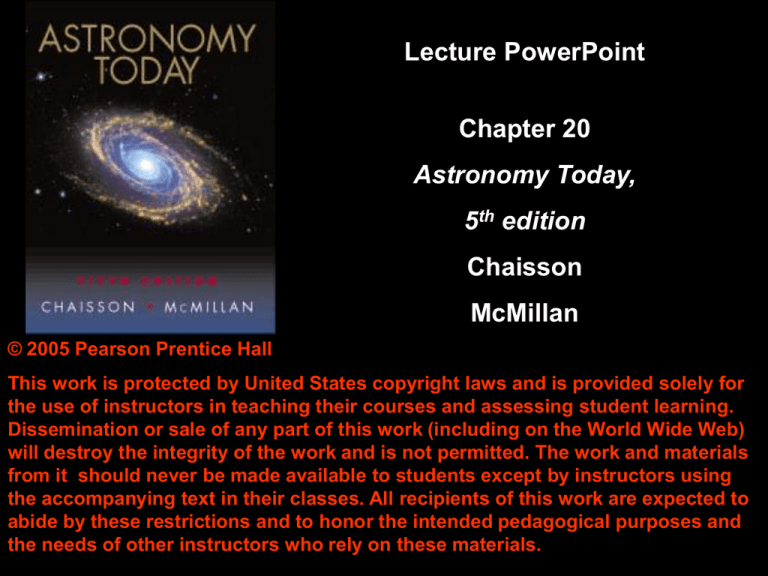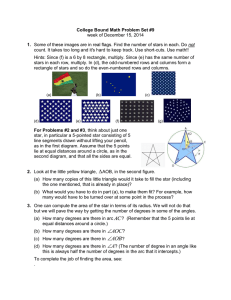
Lecture PowerPoint
Chapter 20
Astronomy Today,
5th edition
Chaisson
McMillan
© 2005 Pearson Prentice Hall
This work is protected by United States copyright laws and is provided solely for
the use of instructors in teaching their courses and assessing student learning.
Dissemination or sale of any part of this work (including on the World Wide Web)
will destroy the integrity of the work and is not permitted. The work and materials
from it should never be made available to students except by instructors using
the accompanying text in their classes. All recipients of this work are expected to
abide by these restrictions and to honor the intended pedagogical purposes and
the needs of other instructors who rely on these materials.
Chapter 20
Stellar Evolution
Units of Chapter 20
Leaving the Main Sequence
Evolution of a Sun-like Star
The CNO Cycle
Evolution of Stars More Massive than the Sun
Learning Astronomy from History
Mass Loss from Giant Stars
Observing Stellar Evolution in Star Clusters
The Evolution of Binary-Star Systems
20.1 Leaving the Main Sequence
We cannot observe a single star going through
its whole life cycle; even short-lived stars live
too long for that.
Observation of stars in star clusters gives us a
look at stars in all stages of evolution; this
allows us to construct a complete picture.
20.1 Leaving the Main Sequence
During its stay on the main sequence, any
fluctuations in a star’s condition are quickly
restored; the star is in equilibrium:
20.1 Leaving the Main Sequence
Eventually, as hydrogen in the core is consumed,
the star begins to leave the main sequence.
Its evolution from then on depends very much on
the mass of the star:
Low-mass stars go quietly.
High-mass stars go out with a bang!
20.2 Evolution of a Sun-like Star
Even while on the main
sequence, the composition
of a star’s core is changing:
20.2 Evolution of a Sun-like Star
As the fuel in the core is used up, the core
contracts; when it is used up the core begins
to collapse.
Hydrogen begins
to fuse outside the
core:
20.2 Evolution of a Sun-like Star
Stages of a star leaving the main sequence:
20.2 Evolution of a Sun-like Star
Stage 9: The Red-Giant Branch
As the core continues to shrink, the outer layers
of the star expand and cool.
It is now a red giant, extending out as far as the
orbit of Mercury.
Despite its cooler temperature, its luminosity
increases enormously due to its large size.
20.2 Evolution of a Sun-like Star
The red giant stage
on the H–R diagram:
20.2 Evolution of a Sun-like Star
Stage 10: Helium fusion
Once the core temperature has risen to
100,000,000 K, the helium in the core starts
to fuse, through a three-alpha process:
The 8Be nucleus is highly unstable, and
will decay in about 10–12 s unless an alpha
particle fuses with it first. This is why high
temperatures and densities are necessary.
20.2 Evolution of a Sun-like Star
The helium flash:
The pressure within the helium core is almost
totally due to “electron degeneracy” – two
electrons cannot be in the same quantum
state, so the core cannot contract beyond a
certain point.
This pressure is almost independent of
temperature – when the helium starts fusing,
the pressure cannot adjust.
20.2 Evolution of a Sun-like Star
Helium begins to fuse
extremely rapidly;
within hours the
enormous energy
output is over, and
the star once again
reaches equilibrium:
20.2 Evolution of a Sun-like Star
Stage 11: Back to the giant branch
As the helium in the core fuses to carbon, the
core becomes hotter and hotter, and the
helium burns faster and faster.
The star is now
similar to its
condition just as it left
the main sequence,
except now there are
two shells:
20.2 Evolution of a Sun-like Star
The star has become a
red giant for the
second time:
20.3 The Death of a Low-Mass Star
This graphic shows
the entire evolution of
a Sun-like star.
Such stars never
become hot enough
for fusion past carbon
to take place.
20.3 The Death of a Low-Mass Star
There is no more outward fusion
pressure being generated in the
core, which continues to contract.
Meanwhile, the outer layers of the
star expand to form a planetary
nebula (above and left):
20.3 The Death of a Low-Mass Star
The star now has two parts:
• A small, extremely dense carbon core
• An envelope about the size of our solar
system.
The envelope is called a planetary nebula,
even though it has nothing to do with
planets – early astronomers viewing the
fuzzy envelope thought it resembled a
planetary system.
20.3 The Death of a Low-Mass Star
Planetary nebulae can
have many shapes:
As the dead core of the
star cools, the nebula
continues to expand, and
dissipates into the
surroundings.
20.3 The Death of a Low-Mass Star
Stages 13 and 14: White and black dwarfs
Once the nebula has
gone, the remaining
core is extremely
dense and extremely
hot, but quite small.
It is luminous only
due to its high
temperature.
20.3 The Death of a Low-Mass Star
The small star
Sirius B is a whitedwarf companion of
the much larger and
brighter Sirius A:
20.3 The Death of a Low-Mass Star
The Hubble Space Telescope has detected
white dwarf stars (circled) in globular clusters:
20.3 The Death of a Low-Mass Star
As the white dwarf cools, its size does not
change significantly; it simply gets dimmer and
dimmer, and finally ceases to glow.
20.3 The Death of a Low-Mass Star
This outline of stellar formation and
extinction can be compared to observations
of star clusters; here a globular cluster:
20.3 The Death of a Low-Mass Star
The “blue stragglers” in the previous H–R
diagram are not exceptions to our model; they
are stars that have formed much more
recently, probably from the merger of smaller
stars.
20.4 Evolution of Stars More
Massive than the Sun
It can be seen from
this H–R diagram
that stars more
massive than the
Sun follow very
different paths when
leaving the main
sequence:
20.4 Evolution of Stars More
Massive than the Sun
High-mass stars, like all stars, leave the main
sequence when there is no more hydrogen fuel
in their cores.
The first few events are similar to those in
lower-mass stars – first a hydrogen shell, then
a core burning helium to carbon, surrounded
by helium- and hydrogen-burning shells.
20.4 Evolution of Stars More
Massive than the Sun
Stars with masses more than 2.5 solar masses
do not experience a helium flash – helium
burning starts gradually.
A 4-solar-mass star makes no sharp moves on
the H–R diagram – it moves smoothly back and
forth.
20.4 Evolution of Stars More
Massive than the Sun
The sequence below, of actual Hubble images,
shows a very unstable red giant star as it
emits a burst of light, illuminating the dust
around it:
20.4 Evolution of Stars More
Massive than the Sun
A star of more than 8 solar masses can fuse
elements far beyond carbon in its core, leading
to a very different fate.
Its path across the H–R diagram is essentially a
straight line – it stays at just about the same
luminosity as it cools off.
Eventually the star dies in a violent explosion
called a supernova.
20.4 Evolution of Stars More
Massive than the Sun
In summary:
20.5 Observing Stellar Evolution
in Star Clusters
The following series of H–R
diagrams shows how stars of
the same age, but different
masses, appear as the cluster
as a whole ages.
After 10 million years, the most
massive stars have already left
the main sequence, while many
of the least massive have not
even reached it yet.
20.5 Observing Stellar Evolution
in Star Clusters
After 100 million years, a
distinct main-sequence
turnoff begins to develop.
This shows the highestmass stars that are still on
the main sequence.
After 1 billion years, the
main-sequence turnoff is
much clearer.
20.5 Observing Stellar Evolution
in Star Clusters
After 10 billion years, a
number of features are
evident:
The red-giant, subgiant,
asymptotic giant, and
horizontal branches are
all clearly populated.
White dwarfs, indicating that solar-mass stars
are in their last phases, also appear.
20.5 Observing Stellar Evolution
in Star Clusters
This double cluster, h and chi
Persei, must be quite young –
its H–R diagram is that of a
newborn cluster. Its age
cannot be more than about 10
million years.
20.5 Observing Stellar Evolution
in Star Clusters
The Hyades cluster, shown here, is also rather young; its
main-sequence turnoff indicates an age of about 600
million years.
20.5 Observing Stellar Evolution
in Star Clusters
This globular cluster, 47 Tucanae, is about 10–12 billion
years old, much older than the previous examples.
20.6 The Evolution of Binary-Star Systems
If the stars in a binary-star system are relatively
widely separated, their evolution proceeds much
as it would have if they were not companions.
If they are closer, it is possible for material to
transfer from one star to another, leading to
unusual evolutionary paths.
20.6 The Evolution of Binary-Star Systems
Each star is surrounded by its own Roche lobe;
particles inside the lobe “belong” to the central star.
The Lagrangian point is where the gravitational forces
are equal.
20.6 The Evolution of Binary-Star Systems
There are different types of binary-star systems,
depending on how close the stars are.
In a detached binary, each star has its own Roche
lobe:
20.6 The Evolution of Binary-Star Systems
In a semidetached binary, one star can
transfer mass to the other:
20.6 The Evolution of Binary-Star Systems
In a contact binary, much of the mass is shared
between the two stars:
20.6 The Evolution of Binary-Star Systems
As the stars evolve, the type of binary system can
evolve as well. This is the Algol system.
It is thought to have begun as a detached binary:
20.6 The Evolution of Binary-Star Systems
As the blue-giant star
entered its red-giant
phase, it expanded to
the point where mass
transfer occurred (b).
Eventually enough mass
accreted onto the
smaller star that it
became a blue giant,
leaving the other star as
a red subgiant (c).
Summary of Chapter 20
• Stars spend most of their life on the main
sequence.
• When fusion ceases in the core, it begins to
collapse and heat. Hydrogen fusion starts in
the shell surrounding the core.
• The helium core begins to heat up; as long
as the star is at least 0.25 solar masses, the
helium will get hot enough that fusion (to
carbon) will start.
• As the core collapses, the outer layers of
the star expand and cool.
Summary of Chapter 20, cont.
• In Sun-like stars, the helium burning starts
with a helium flash before the star is once again
in equilibrium.
• The star develops a non-burning carbon core,
surrounded by shells burning helium and
hydrogen.
• The shell expands into a planetary nebula, and
the core is visible as a white dwarf.
• The nebula dissipates, and the white dwarf
gradually cools off.
Summary of Chapter 20, cont.
• High-mass stars become red supergiants, and
end explosively.
• The description of stars’ birth and death can be
tested by looking at star clusters, whose stars are
all the same age but have different masses.
• Stars in binary systems can evolve quite
differently due to interactions with each other.



